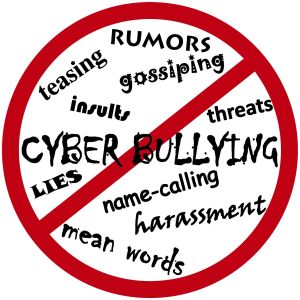Name calling, harassment and other forms of bullying are already a big challenge with today’s youth. However, with smart phones, the internet and social media, bullying has been taken to new levels. According to a study conducted by the Pew Research Center, 59 percent of teens claim to have experienced at least one of six different types of online abuse.
The primary forms abuse people face online are name-calling and the spreading of false rumors. About 42 percent of teens on the Pew study reported being called offensive names either online or over the phone and 32 percent of those teens reported false rumors being spread.
Misery loves company
Licensed esthetician and makeup artist Lauren Basile has experienced cyberbullying before and describes it as “disgusting.” A former friend of her best friend constantly stalked her friend’s social media by creating fake accounts and following her followers/friends, including Basile.
Since she comes from a big family, Basile has some followers who know someone in her family despite not actually meeting them. This led her to accept the girl’s friend request. When her best friend objected, Basile unfriended the girl.
That did not stop the girl from somehow getting into Basile’s email, changing her password and hacking into her social media account. While there, she deleted almost everything Basile had and replaced them with very explicit and sexual images involving prostitution.
To make matters worse, the girl direct-messaged Basile’s friends and say hurtful things to them. Luckily for Basile, her friends knew something wasn’t right so instead of automatically assuming she hurt them on purpose, they asked if she was OK and showed her the messages that were sent from her account. Basile was shocked to see what had happened and was scared for her family, specifically her brothers, whom she’s very protective of.
“If their friends saw that, or they saw that, it would go right back to my parents, bringing shame onto my family,” Basile said. “When it comes to my family, I would put on a m———ing war.”

Basile was glad her brothers didn’t see her social media page but was more grateful that her friends just asked what was going on. She is very close to her friends and describes their relationship with each other as a sisterhood.
“We always empower each other, we’re always there to support each other…I have a group chat with them and they tell me everything,” Basile said. “I’m so happy they didn’t believe that because I really don’t know what the f— I would do without them.”
Even after Basile deleted everything and made new accounts with different names, the cyberbully kept coming after her with fake accounts and constantly apologizing to her. This forced Basile to deactivate her Facebook and Instagram accounts.
Basile wants to enhance her career in social media at Cabrini, but she’s worried the cyberbully will come back because she has more to lose now. Especially in the case of her family, job and potential employers who may reject employment if they see graphic and profane pictures or posts on her social media.
“Not only are you shaming my family, you’re blocking my income,” Basile said.
While she feels bad for the cyberbully, Basile said she knew what she was doing and had no excuse to hurt others. Especially since her best friend, despite having a horrible childhood herself, has made a successful and happy life for herself.
Cyberbullying on race and gender: is there a difference?
While boys and girls have equal chances of being cyberbullied, girls are more likely to be victims of cyberbullying as a poll conducted by Pew has shown that 39 percent of girls have experienced the spreading of false rumors compared to 26 percent of boys. Additionally, 29 percent of girls have received unwanted explicit photos compared to 20 percent of boys.
Assistant criminology professor Dr. Katie Farina said that the fact that girls are supposedly more likely to become victims of bullying is part of a phenomenon called the “Mean Girls Phenomenon.” According to her, girls seem to be the same when bullying online and in person.
Farina said that boys are more likely to be bullied than girls, especially in person, because in-person bullying has a physical component and boys are socialized to be aggressive. When it comes to cyberbullying, Farina said that there’s little difference between the rate boys and girls experience it because there’s no physical notion.
“The intention of cyberbullying is to be embarrassing,” Farina said. “It’s to cause embarrassment and feelings of unease. So, I think that levels the playing field between boys and girls.”

Farina also pointed out that girls are more likely to be verbally assaulted and girls are more likely to cyberbully and be cyberbullied because of the verbal component as well as how they bully.
In society, people are socialized to expect certain behaviors that are considered normal and when someone seeks to break out of those norms, it is a cause for ridicule. According to Farina, sexual orientation and sexual minority status are major causes because we live in a heteronormative society where people are taught that the only normal relationship is between a man and a woman.
“Whenever you see someone who is stepping outside of that norm, it’s a cause to ‘other’ them and to be like ‘I’m not like them,’” Farina said. “So to prove the world that I’m not like them, I have to make fun of them.”
There have been many stories where people were cyberbullied because of their sexual orientation which pushed them to self-harm and suicide. Case in point; former Rutgers University student Tyler Clementi‘s roommate secretly recorded him making out with his boyfriend and uploaded it to the internet which pushed Clementi to suicide.
When it comes to explicit images, boys are more likely to send them. According to Farina, it is technically considered child pornography since it consists of sending sexual pictures of people under the age of 18.
Girls who cyberbullied are more likely to be the same in person as they are online such as being negative, gossipy and attacking a girl’s looks, reputation and attitude since they’ve been socialized on what’s considered “pretty.”
This was especially the case with Basile friends since the messages they got called them out for their looks. She despised those messages too because she claimed that her friends are incredibly gorgeous.
Money isn’t everything
Pew’s research claims cyberbullying also varies based on income as 24 percent of teens whose family has a household income of $30,000 faced more cyberbullying than the 12 percent whose families have a household income of $75,000.
Farina disagrees with this claiming that most surveys that go out usually ask about income and middle and high school students don’t know how much money their parents are making. Other factors included looking into where students live, their zip codes, even how many bathrooms a person had to determine someone’s socio-economic status.
“I really don’t think that income has an impact upon bullying because bullying rises above that,” Dr. Farina said. “It doesn’t matter if you’re rich or poor, they will find something to make fun of you for.”
What can be done?
Many school officials, tech companies and lawyers have begun taking measures to end cyberbullying by enacting laws to prevent cyberbullying, implementing policies that punish students responsible, and tech companies bringing out tools to help prevent it. However, teens feel that dissatisfied with current efforts.
According to a poll conducted by Pew, 59 percent of teens feel that parents are the only ones that are really making an effort to end cyberbullying and 79 percent claimed that elected officials and politicians were only doing a fair or poor job.
Basile agrees with this since she and her best friend went to the police regarding her cyberbully and very little was done about it. The first officer she talked to neglected it claiming it was simple high school drama. The other officer attempted to look into it but there was little he could do since the cyber laws were different and the cyberbully’s usage of fake numbers made tracing her very difficult.
Basile also thinks that there needs to be more done in terms of curbing cyberbullying such as having more laws and making things more traceable. Especially in the case of her cyberbully who used manipulation and playing the victim.
“When a serial killer kills and he leaves evidence behind, you trace it back to that person,” Basile said.
Behind a screen or in person; it doesn’t matter
Cyberbullying is just as harmful if not worse than in-person bullying and should be treated as such. Since it has led to serious problems including self-harm and suicide, most agree that there should be more done to curtail it. Additionally, such people believe that having a rough past doesn’t give anyone an excuse to make others miserable.
“I surpass everything,” Basile said. “That b—- had nothing better else to do other than try to destroy me, but she failed. I’m still here, I work full time, I go to school full time and I’m living my best life.”


